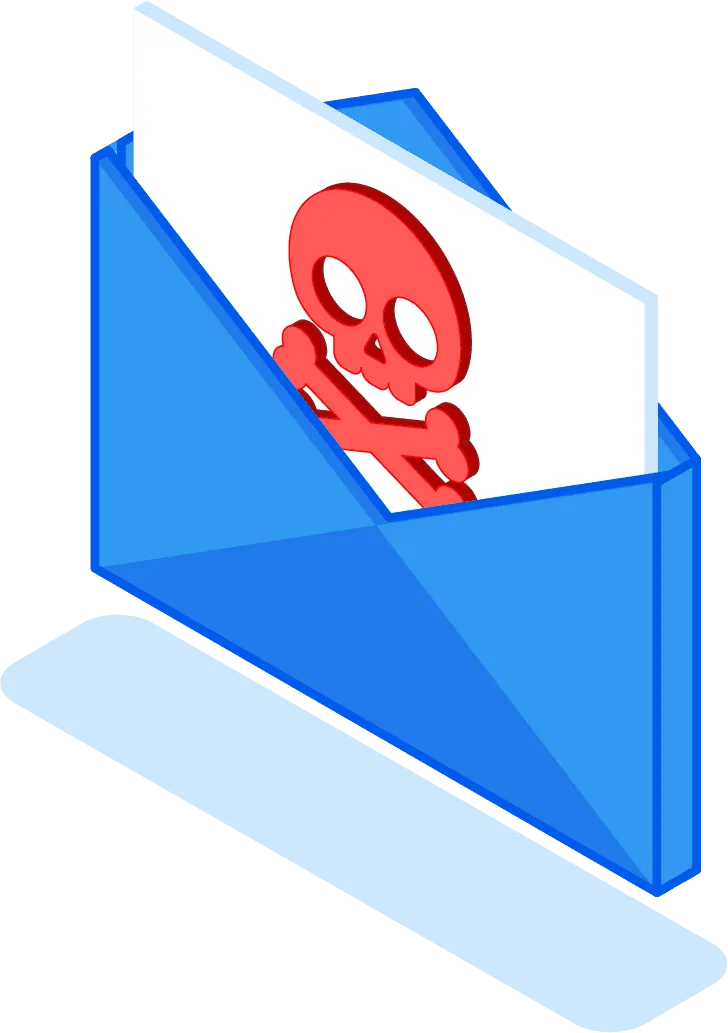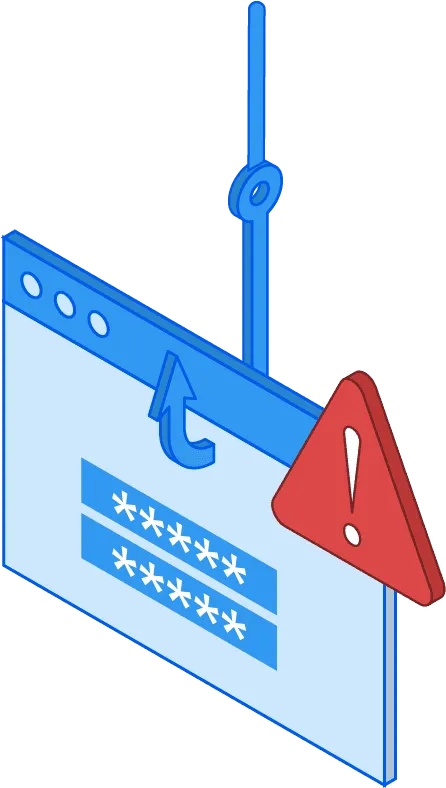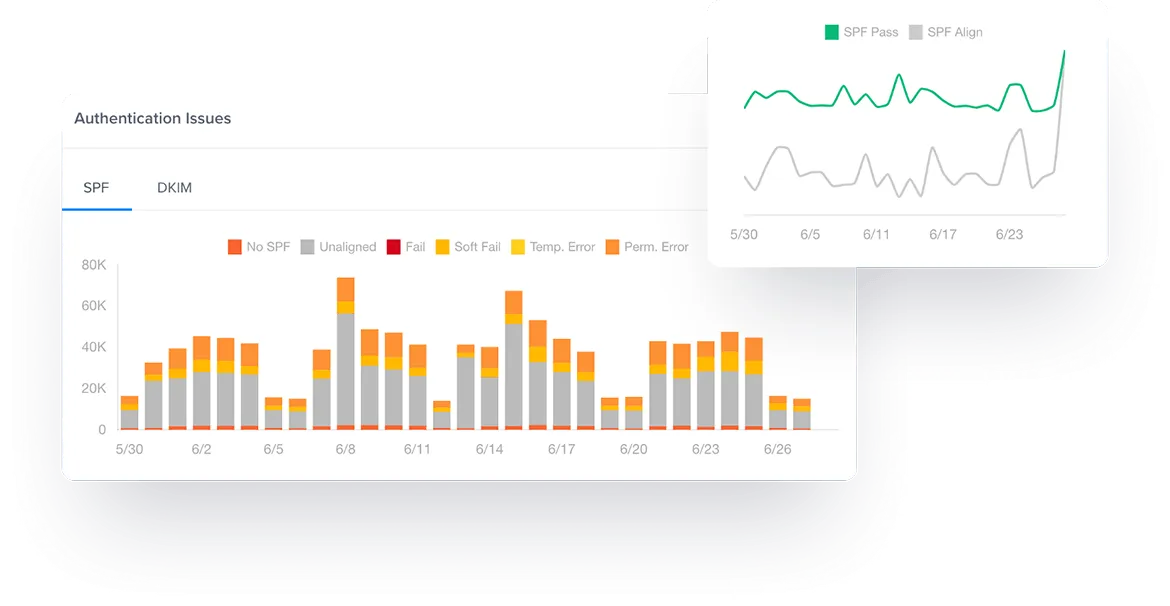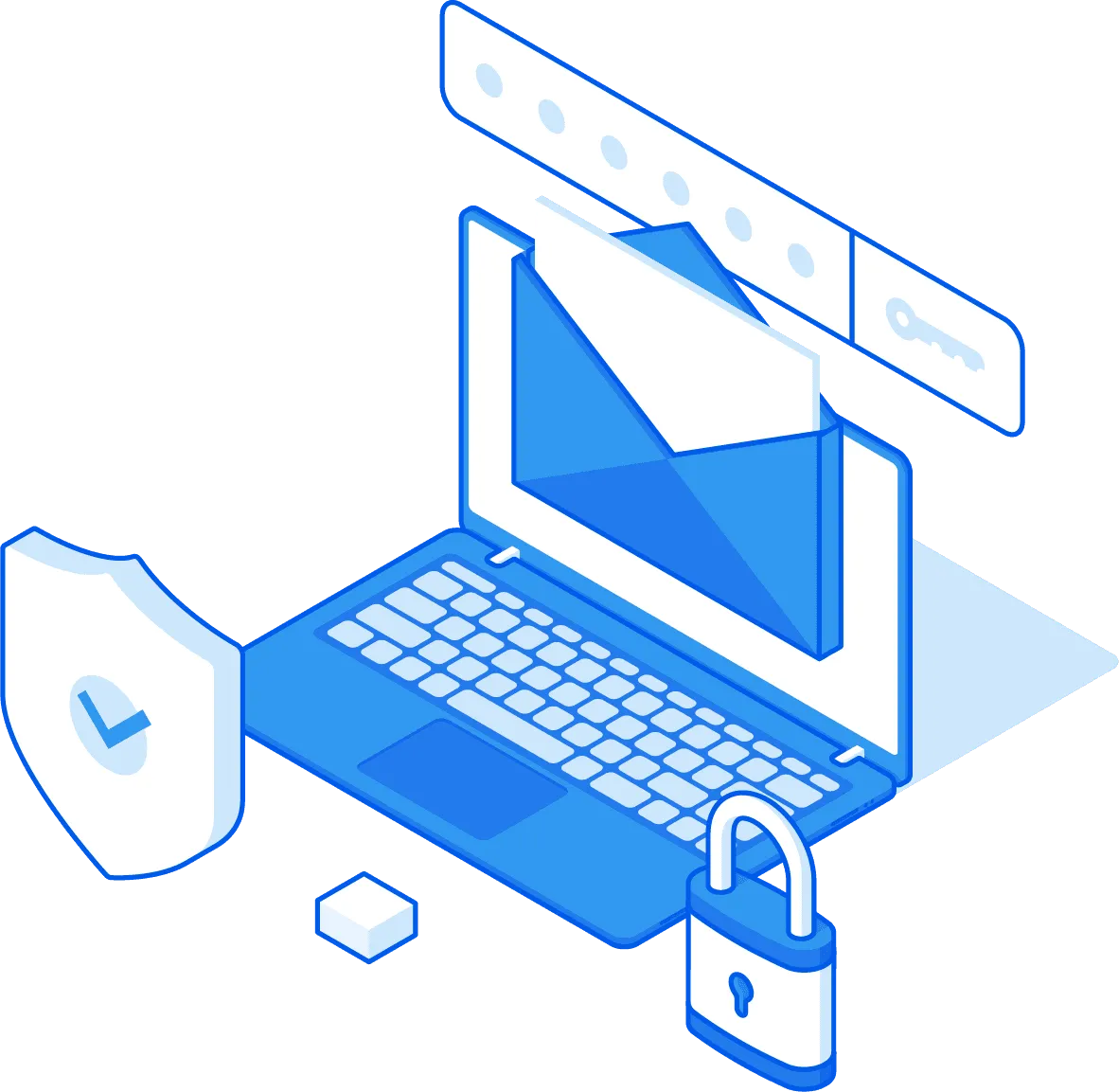Many email marketers may believe their email program is optimized and bulletproof, especially if their performance is satisfactory. However, there could be danger lurking. There are thousands of malicious agents hijacking domains daily. Spammers are growing more sophisticated in their tactics, enabling them to mimic your domain to look more legitimate. As a result, email experts created email authentication and validation standards. Without sufficient email authentication, your brand is at much greater risk of damage.
Phishing scams and spam reaching your customers could be catastrophic, ranging from reputation erosion to financial impact for your business or your customers. Email authentication vulnerability is something many email marketers have little to no experience with until it is actively causing harm.
90%
of cyberattacks start with email messaging
*(source: Proofpoint)

Many experienced marketers are unaware of the importance and complexity of using email sender authentication to shield their email marketing programs from harm. While there are many options, technologies, and steps to follow to authenticate email to the fullest, it can be overwhelming to know where to start.
The following information will explain how email authentication works, how to authenticate your email, and why it is a crucial component of any email marketing program. You’ll have a better understanding of how to start your journey toward safer email campaigns to ensure both your organization and your recipients are protected to the best of your ability.
Custom domain authentication
If you are using a domain outside of Gmail, AOL, and others, you need to ensure your domain is protected to continue building and retaining your audience. Without the benefit of authentication on your own domain, all your signals sent to mailbox providers (MBPs) indicate the mail transfer agent (MTA) rather than the original sender.
Benefits of custom domain authentication
At the most basic level, properly authenticating your domain makes it more difficult for malicious spoofing or hijacking of your brand’s identity. Using authentication in conjunction with a custom domain requires bad actors to create a vanity URL to match and mimic your domain. They don’t have the ease of simply mimicking a general domain like Gmail, which requires little to no effort.
Do I need custom domain authentication?
The following email authentication information assumes the use of a custom domain.
How does email authentication work?
Email authentication is a collection of activities created to confirm and verify the identity of an email sender. These techniques include Sender Policy Framework (SPF), DomainKeys Identified Mail (DKIM), and Domain-based Message Authentication, Reporting & Conformance (DMARC). By confirming the sender is who they claim to be, email authentication is a key component of protecting both the brand and email recipients from spoofing and phishing.
Authenticating email provides several benefits. As a sender, you are no longer an easy target for bad actors to hijack. This means you lower your chances of being spoofed or other undesired uses of your brand name.
This protection extends to your mail recipients as well. You’re blocking as much spam and dangerous mail to their inbox as you can. While you can’t fully inoculate subscribers from phishing attempts, with email sender authentication you can be more confident your email isn’t contributing to the problem.
Finally, you’re providing overall brand protection beyond email. Many high-profile companies fell victim to email scams over the last few years. When email is successfully used to extract customer information, your business could be responsible for monetary damages. Beyond the financial impact, brand reputation, trust, and loyalty quickly erode without consumer confidence.
220%
Phishing incidents rose by 220% during the height of the pandemic compared to the yearly average as spammers capitalized on the uncertainty of the pandemic and influx of email.
*(source: 2020 Phishing and Fraud Report)

Three primary email authentication methods
There are three core methods of email authentication methods: SPF, DKIM, and DMARC. These are foundational and can be built upon with newer, more nuanced technologies. Without employing DKIM and SPF, you cannot add the benefits of DMARC. This tiered and layered approach multiplies the security of your domains and, consequently, your brand.
1. SPF
Sender Policy Framework, or SPF, is a basic email authentication technology. It’s simpler to configure than several of the other steps you can take to authenticate email messages. Plus, you’ll need a properly configured SPF record to allow implementation of other, more complex technologies.
At its most basic level, SPF is used to prohibit email forgery. It involves code called an SPF record, which is placed in the sender’s Domain Name Server (DNS). Your DNS record is public, but only relevant to players in the email space. The record allows mail servers receiving the mail to verify the content is truly from the sender.
If the server does not confirm the records match or detect there was manipulation in transmission, the server can reject the message.
That being said, SPF is a relatively simple trust indicator and works better in tandem with other, more secure email authentication methods. Put frankly, it’s a can’t-skip step in building an effective email program.
2. DKIM / DomainKeys
Where SPF is a straightforward step toward security, DomainKeys Identified Messaging (DKIM) is just as crucial but significantly more complex. DKIM requires a series of setup steps and, later, several checks during message transmission.
A major differentiator from SPF, DKIM uses encryption. This involves building encryption tokens for both the sent email and the receiving server. First, as a sender, you’ll need to identify which components of your emails you want to use for verification. This could be the entire message or just an element of the header. Once you determine this, you can encrypt those portions. This is what will be checked to ensure there was nothing manipulated in transmission from sender to receiver.
DKIM uses several “keys.” These keys include a pair of keys for encryption itself, a public key living on your DNS, and a private key residing on your mail servers.
The receiver sees the DKIM signature, then does a DNS lookup to find the public key. It then decrypts the key and creates its own hash of the information it sees. Finally, as the message arrives at the MBP, it will verify both keys match. If it does, nothing was changed in transmission as determined by the keypair match. At this point, the email message is considered valid and is an additional data point for MBPs to consider when choosing to deliver.
3. DMARC
Domain-based Message Authentication, Reporting & Conformance (DMARC) is the finishing touch on a well-authenticated email program. This validation system detects and prevents domain spoofing and phishing. Because DMARC leverages both SPF and DKIM, it directs MBPs what exactly to do when both email authentication steps fail.
- p=none: Take no action at all.
- p=quarantine: Filter messages into a quarantine folder and do not deliver to the inbox.
- p=reject: Do not accept the mail to any box.
Beyond setting up the standard for full protection, it’s imperative to analyze and understand the DMARC reports generated at each policy level. Additionally, you’ll need to have an implemented DMARC policy to qualify to use BIMI, a new authentication standard being adopted by some of the largest mailbox providers.
There’s much more nuance to DMARC than just covered, but you can read more about it here.
Everest proactively monitors the health of your sending infrastructure by tracking SPF, DKIM, DMARC to ensure these protocols are working correctly.

BIMI
The newest entry into the email authentication space is Brand Indicators for Message Identification (BIMI). Although BIMI itself is not a means of email authentication, it aims to drive adoption of strong sender authentication for the entire email ecosystem by requiring the use of DMARC.
When set up, BIMI places a small graphic next to a sender’s From name, which is a vanity name rather than the sender’s email address. Most companies select a version of their recognizable logo to use as the graphic image. This visually reinforces your brand identity, and provides reassurance for the recipient to trust the email message.
But BIMI isn’t readily available to any sender. Instead, the sender must implement the recommended email authentication protocols. This is how it’s closely related to email authentication but doesn’t necessarily provide any technical protection. Instead, it is a sign to the recipient the mail is truly from the company rather than a spammer.
BIMI requires the use of a strict DMARC policy, which in turn requires SPF and DKIM. While BIMI is more marketing-oriented for brand impressions, it’s a nice perk of being thorough in your email authentication.
Other email authentication methods
While SPF, DKIM, and DMARC are the most commonly known and used email authentication methods, there are a few other components available for use. These standards are either deprecated or have not yet gained widespread support, but sometimes still surface in discussions of email authentication. Familiarity with them can help you determine their appropriateness for your program.
Sender ID
While Sender ID seems almost identical to SPF, they differ in how they detect fraud. How? They each check different headers to perform different functions. Yet, because Sender ID requires a published SPF record to operate successfully, it enhances the protection afforded by SPF.
Sender ID codes are nuanced to indicate the type of issue detected, if there is any.
- Pass: Everything matches and the mail is clear for delivery.
- Neutral: The findings are inconclusive, so it doesn’t necessarily indicate fraud, but is not clear enough to pass.
- Soft fail: The purported responsible address (PRA)’s signals don’t match, but there’s only evidence the IP might not exist.
- Fail: The IP address is definitively not permitted. Either there is no PRA incoming at all or the sender domain isn’t real.
- None: There’s simply no SPF data published in the sender’s DNS.
- TempError: The DNS failed but it’s temporary, due to an unavailable DNS server or similar.
- PermError: There is an error not related to a temporary problem, and instead the DNS record has something truly wrong, such as a record format error.
ADSP
Author Domain Signing Practices (ADSP) can be used as an extension to DKIMto authenticate emails. This allows relaying domains to publish the signing practices it uses on behalf of senders. This isn’t much to worry about from the sender side of email, but you should be familiar with how your ESP is handling your mail.
VBR
iprev
An IP reverse lookup simply confirms an IP’s DNS is properly configured. It doesn’t necessarily indicate trustworthiness, so it shouldn’t be used as a means of email sender authentication but it does note whether or not the record is valid.
DNSWL
FAQ
How do I authenticate my email?
By implementing the three core email authentication methods: SPF, DKIM, and DMARC, you’ll be able to protect your email. But each protocol requires steps to take to configure the elements properly. SPF is the starting point and is the easiest place to start. Once it’s in place, take the next step in email authentication by adding DKIM. For added protection, include DMARC and a DMARC reporting tool to keep an eye on any unauthorized mail coming from your domain. Then you can take advantage of BIMI as well.
What are some alternatives to email authentication?
How do I ensure my email authentication is working?
Discover how Everest can help you set up and monitor proper email authentication to keep your program safe and secure.
